 Restart Retail Area in City Mall Made from Ship Containers |
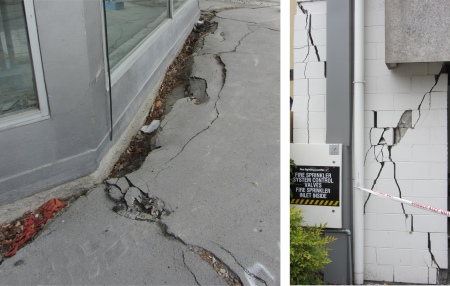 Some Buildings Sank, Others Cracked |
I arrived at the campsite to be greeted by an ever so friendly grey-haired gentleman, who provided me with maps and details of the bus service to the city and back. The site was compact with modern facilities, full of flower beds; I couldn't ask for more.
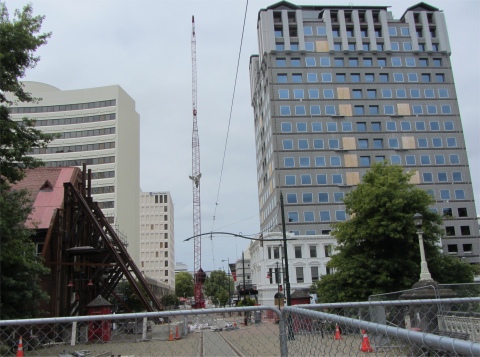 All Apart from the Propped Up Information Centre on the Left Will be Demolished |
As the bus headed to town, it passed the Women's Hospital. I could see discoloured patches on its cladding where cracks had been filled in. The bus station was a large two-dimensional affair, built over the expanse left by demolished buildings. I was aware straightaway by the tape and barriers that vehicles and pedestrians were marshalled away from dangerous zones.
Up until the earthquake, Christchurch had been a genteel, polite, quintessentially English university town. The strong link with the mother country was not surprising considering the city's history. Ironically, the first settlers on the Canterbury Plains were the Scottish brothers, William and John Deans, who settled in the locality in 1843, naming it Riccarton. The government bought the land five years later, and in 1849, Robert Godley founded the Canterbury Association with the Archbishop of Canterbury at its head, and largely consisting of worthies from his old university college, Christ Church, Oxford, with the aim of establishing a new Anglican settlement; literally a transplanted model of middle-class structured England as opposed to another colonial scruffy outpost. In 1850 four ships arrived bringing 782 settlers to the whaling base of Lyttelton, bound for Christchurch. Carving out an existence soon became the overriding focus for the immigrants, but although the Association collapsed in 1855, the ideals that had been originally planted had a profound effect on the cultural identity, and the city began to prosper as the most English of the nation's cities.
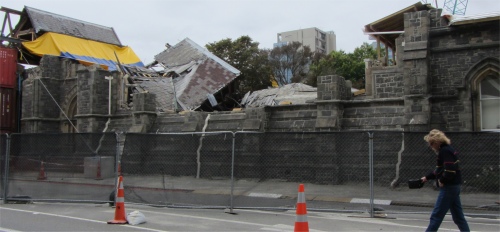 A Former Proud Church |
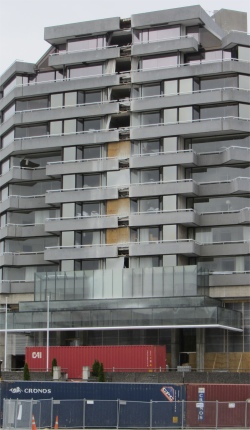 One Half of this Hotel Sank |
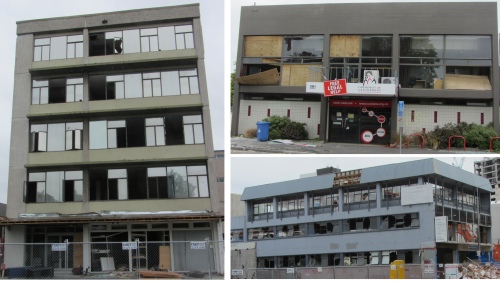 A City of Broken Glass |
Oblivious to it all, a young Japanese boy, who can't have been more than 12 years old, stood on the pavement with an electronic keyboard, giving flawless renditions of a variety of classical music. He performed purely from memory, his eyes surveying up and down the street as his small hands moved effortlessly over the keys.
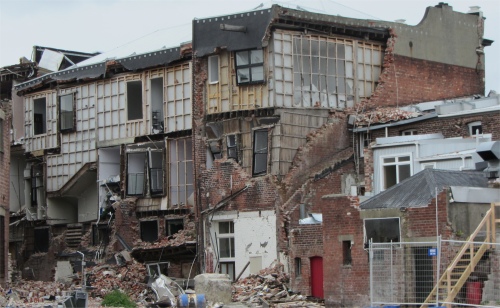 Brick Shell Now Rubble While the Interior Wooden Cladding Still Stands |
"This street was a shopping street with tall buildings along each side. When the first earthquake struck last February, masonry and glass fell everywhere. A small girl was killed there," he said, pointing to a spot 3m away from where we sat, " and a few others were killed further on. The whole lot was demolished. Ballantyne's, the two storey building on the corner, which had suffered much damage, pulled together with a few other retailers to try and kick start the retail business again, and it was they who conceived and financed these two storey buildings built out of containers last August. They also helped finance the new bus station so as to get people from the suburbs into the city for the retail and business sectors. Now those tall buildings you see over there are to be demolished. In fact 1,000 plus buildings are scheduled to be demolished, the tall ones to be taken apart piecewise until they are only five storeys tall before they are pulled down. Buildings erected after the 80s stood up quite well to the quake since they had been designed to meet new international standards at the time. Earlier buildings had no set of rigorous requirements to work to."
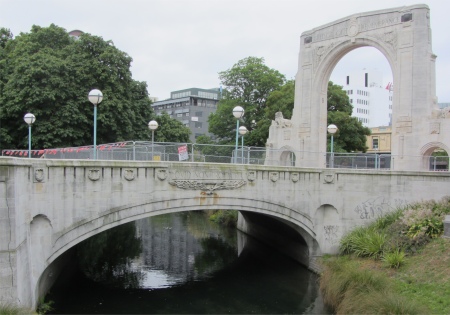 Bridge of Remembrance Over the Avon River, Complete with Its Own Set of Cracks |
"Have any copies of John Wilson's Christchurch Lost come in?" he asked the lady at the desk. "Sorry, we haven't, but you can try Mr ...." He cut her short with, "No he hasn't got any either. I'll try again in the morning, thank you."
He explained to me that a plan had been put together to try and rejuvenate the city. Efforts will be made to expand the retail sector, and the first push in the CBD will be a new IT complex. Many of the city's hotels were rendered useless, and it was recognised that this had to be addressed if the city wanted to rebuild its tourist trade. Of course a massive clearance operation had to be implemented first. One issue coming to the fore was due to the fact that people now no longer wanted to work in buildings more than five storeys tall. This was a downer for property developers who saw tall buildings as a means of getting maximum return on their investments.
He continued, "Insurance companies tend to hide behind "Acts of God" to minimise pay-outs. However, the excesses which we all pay into a central government fund for such disasters are the cover for "Acts of God". There is sufficient to cover the Christchurch disaster, but there will not be enough left over to cover another such calamity. We are still suffering from aftershocks, there have been in excess of 9,000 so far."
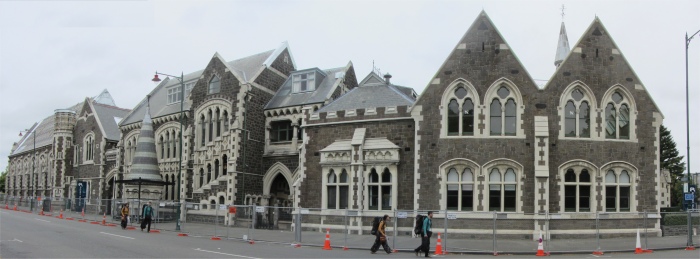 The Arts Centre |
The chap enquired about my trek. "You'll find the southern islanders friendlier than their northern counterparts," he said. Then he added, "Auckland is only interested in money, Wellington in power, Christchurch in family, and Dunedin and Invercargill in both family and community." I took on board his statement.
He was a kind, helpful and friendly chap, and I thanked him profusely for all his help and information. I started to walk around what I could of the city. It was a case of following a very disjointed zigzag boundary of barriers around the city centre. The interior was a maze of deserted streets, with rubble and glass still strewn on the roads, and weeds poking through the roads and pavements in places. Cranes had sprouted up like a spidery forest, and countless bulldozers sat perched on mounds of rubble like squat yellow dung beetles. Some buildings were patched up with chipboard for windows and bright new corrugated iron on the roofs to cover gaping holes. The old red brick visitors centre was still standing, only just, with a cradle of stout timbers holding it up.
 Christ's College |
I picked up my walk around the periphery of the city, and vast open areas came into view, all flat expanses of flattened rubble, many turned into makeshift car parks. I took a short cut across one such expanse of rubble, and wondered whether I was treading on a former business or residential building. Perhaps people had lost their lives in the building.
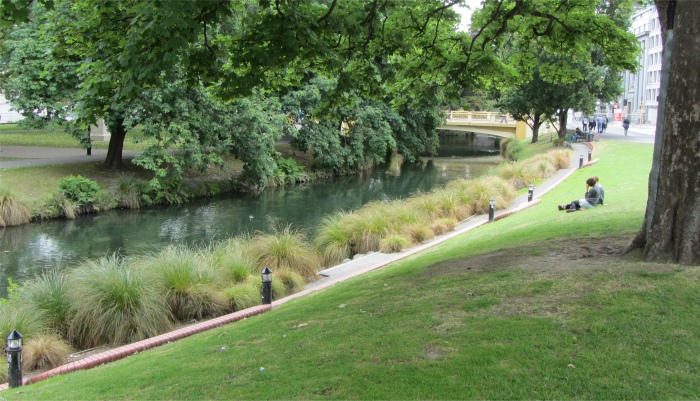 A Quiet Haven by the Avon River, Minus the Punts |
I continued my disjointed tour. I'll let the pictures talk for themselves. There was a touching scene at a restaurant near the Bridge of Remembrance (remembering the NZ dead from the World Wars). The windows of the restaurant were still intact, and inside was a time capsule. Here were tables with the tide marks of half drunken bottles of wines, broken crockery on the floor, a cap still lying next to a plate and so on, all left as they were when people flooded out of the restaurant in sheer panic when the quake occurred some 11 months ago.
The Arts Centre and Christ's College suffered relatively minor damage. A short walk took me to the eastern side of Hagley Park, a 405 acre site of green fields, tranquil lakes and streams right in the city centre. The park was cut-off from the city to the east by the Canterbury Museum, founded in 1867, and Christ's College, the city's most elite public school, built in 1850. The Botanic Gardens were situated in the centre of the park, almost entirely encircled by the river. Known as the "Garden City", Christchurch has many beautiful parks and gardens throughout the city. In 1997, Christchurch was judged "Garden City of the World" in the Nations in Bloom International Competition. Today, they were the perfect antidote to the scenes I had witnessed earlier walking around the streets. The heady aromas from the blooms blotted out the stench of dust and decay.
The whole saunter around the derelict wasteland that was once a beautiful city was saddening and moving. I could also sense the same sense of loss in the other equally dazed sightseers who were stunned into silence. Visitors like me surveyed the scenes in hushed reverence, normally more reserved for churches than city centres. Locals spoke with firm voices, pointing out to friends and relatives where this used to stand or that used to be. The locals were a breed who had fighting spirit and never seemed to whinge.
